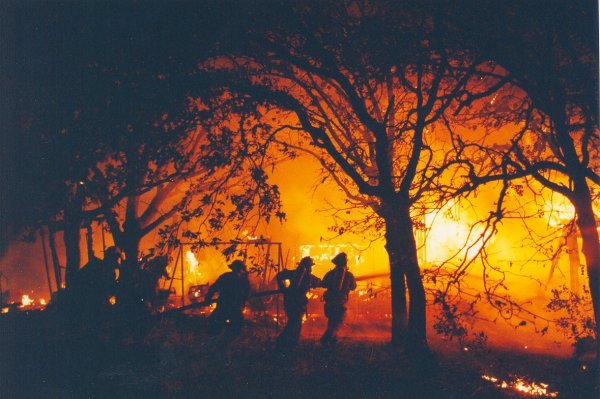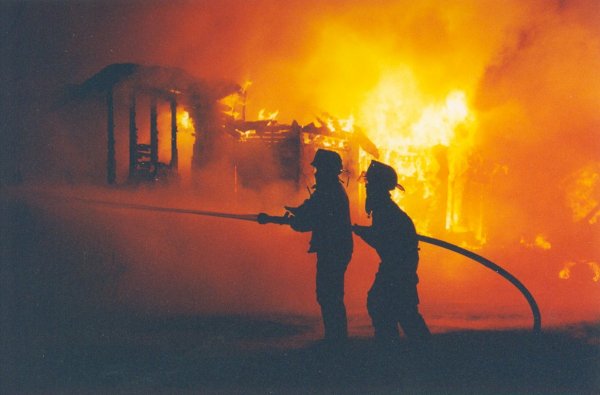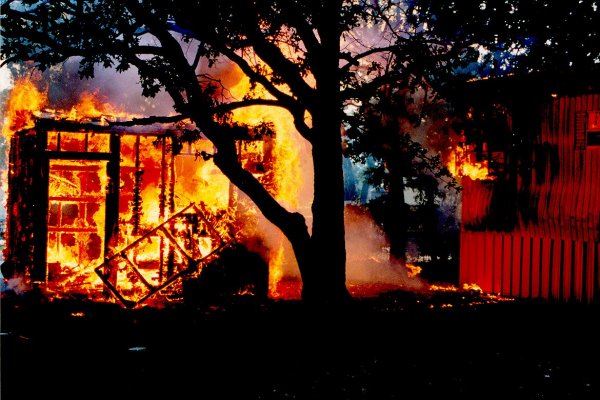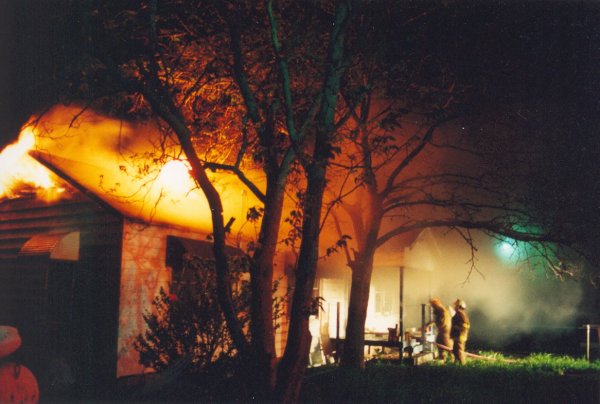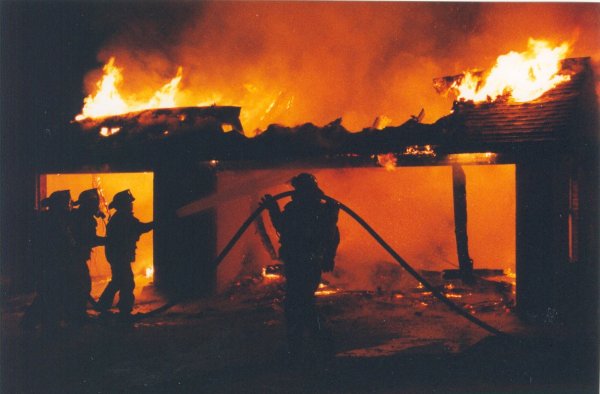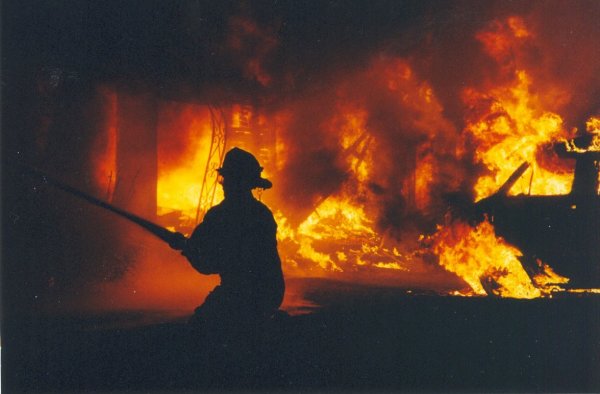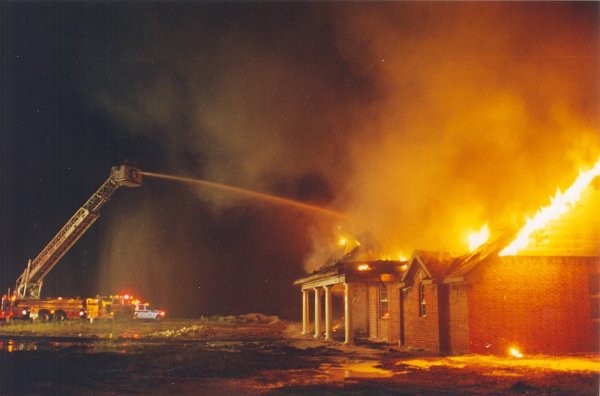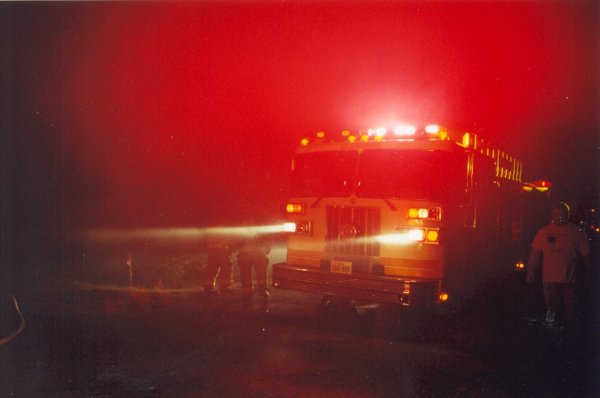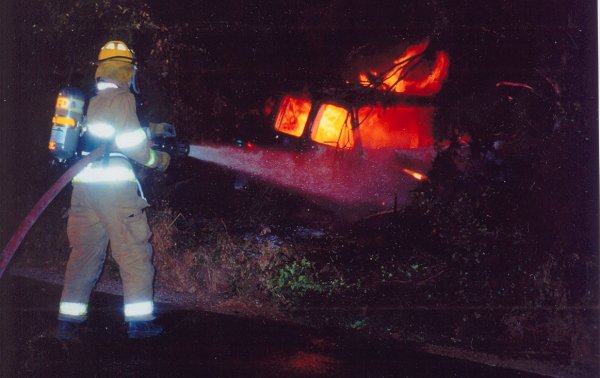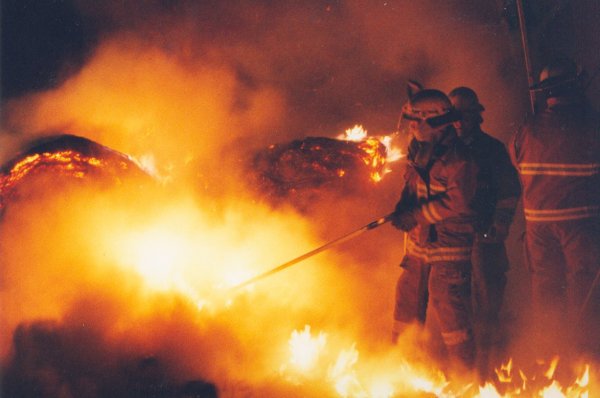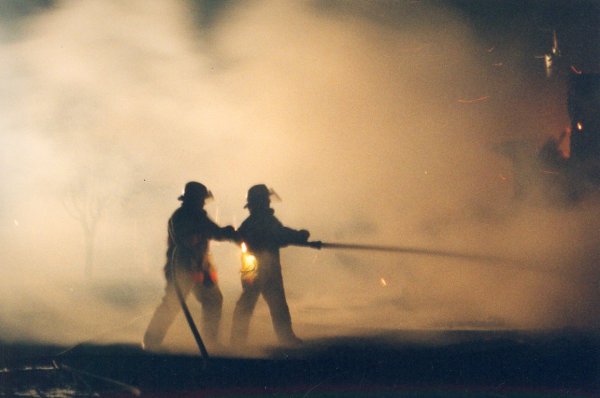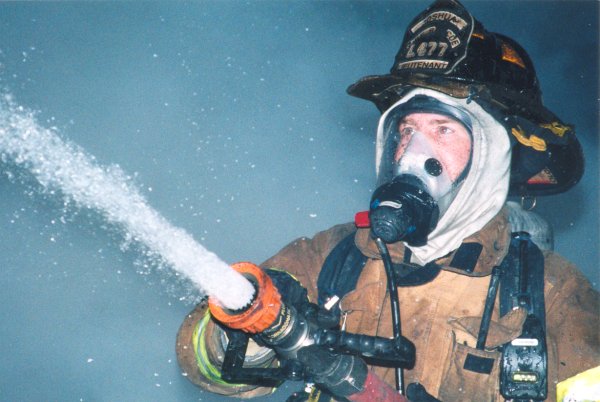|
ART
AMONGST THE FLAMES by
Wayne Tomblinson I
am a real estate broker in Keene, Texas, population 5,000, which is located in
Johnson County just south of Fort Worth. I started doing fire photography in
2001 as a hobby. I enjoy being able to give something to the volunteer (and
paid) fire fighters for all their hard work they do for their communities. Being
a photographer of fire and EMS incidents takes a different commitment and
investment than most photography. You do not select the time and the place to
make your photos. The
equipment needed, in addition to a camera, is several radio scanners to listen
for the fire departments calls. I have a scanner in my home and one in my
office. Also, a handheld scanner to use in my vehicles and while I’m at the
scenes. I have three county maps--at home, at my office, and in my
vehicles--to find the location of the current incident. These scanners are
tuned to the rural Johnson County fire dispatch channel, as well as the City
of Cleburne paid fire department channel. Cleburne is located 5 miles from
Keene. While I cannot always have the scanner on during the day, they are on 24 hours a day at my office and my home. Many of the opportunities for photos come in the middle of the night. You have to make an immediate decision when you hear a fire or wreck dispatched. The key words to listen for are “fully involved structure fire” or “major 1050 (accident)”.
If
you do not leave immediately you will miss the best pictures. Volunteer fire
departments will yield the best pictures. They have to leave where they are
at, including getting dressed in the middle of the night, travel to the
firehouse, put on their gear and wait for a full crew of two to four
firefighters. Then they proceed to the scene. All you have to do is go
directly to the scene. The majority of the time, I am the first one on the
scene in the Fire District where I live. This fire district covers a 4 to 5
mile radius. Water
supply is a problem in a rural area for the fire departments. Many times the
initial fire truck(s) run out of water and they have to wait on mutual aid
from surrounding departments to bring water. When this happens the fire flares
back up, this does give you a longer time period to take photos. I
have found that I can cover an area of a 12 to 15 mile radius. This means I am
covering 6 volunteer fire department districts and 2 paid fire departments. When
I arrive at the scene, my camera is already loaded with film and I have at
least 2 extra rolls of film in my pocket. I keep my camera and 4 rolls of film
in an insulated soft bag that was designed to hold two six-packs of Pepsi. I
put towels down on the floorboard of my rear seat, then the bag, and then
cover it with a blanket. This helps protect the camera and film from the heat
or cold. You cannot stand in one spot and get good shots. I am continually moving around the scene looking for and framing shots in my mind. When I see something that looks good, I then frame the shot in my camera, maybe moving a little one way or the other to get the best shot. After I take one, two, or three shots, maybe using different zoom lengths, I immediately start walking around looking for my next shot.
At night I love to do silhouette shots. This will take a little practice, as you have to put the firemen directly between the flames and your camera. Brick homes are the hardest because you may only see the flames through the windows. Turn your flash off and be sure to shoot several pictures using different zoom lengths.
Another
type of shot I like is natural lights at night using no flash. I use the
lights of the emergency vehicles and/or the floodlights of the fire truck on
the firemen. Experiment with one shot without flash and the one shot with
flash of the same scene and look at the amazing difference. A
good size fire fully involved will give you between 30 minutes to over an hour
of good shots with flames after the firemen arrive in rural areas that are
without fire hydrants and 10 to 30 minutes in a paid fire department. But don’t
stop shooting there are still a lot of good shots to take. Look for exhausted
firemen on the outer edges, around the water bucket and sitting on the running
boards of the fire trucks. They can make great pictures. I
take between 80 to 120 pictures of a large fire. From those I will get 5 to 15
really good shots and another 15 to 20 good shots. I
use only fully automatic operation of the camera. There is not time (or the
light at night) to try to manually make camera settings. The only decisions
that need to be made are flash or no flash and wide angle or the amount of
zoom to get the effects you are looking for. It is important to work well with the various fire departments. Park out of the way and when you are walking around the scene, do not get in the way of the fire fighters doing their job. Watch for hoses and firefighters bring ladders or other equipment off the trucks. If you want to get closer to the building be sure to check with the incident commander or a fire fighter. Your zoom lens allows you to normally stay a safe distance away from the building and out of the fire fighters way.
The
fire departments I cover love to see me arrive at the incident because they
know I will give them a complete set of pictures taken. Then, I also give them
framed 5 x 7 or 8 x 11 pictures to hang in their firehouses. The chiefs have
told me they use them for training purposes as well as letting the
firefighters and their families see them in action. A
good way to write off your hobby is to approach your local paper or papers.
The first fire picture I took, I went to the Cleburne Times, the paper that
serves the county I live in, and spoke to the editor. I said, “You don’t
know me but I started a hobby and if you would like to publish my pictures,
all I want for compensation is for you to give me photo credits.” They were
glad to print them. After about 3 months and 15 to 20 pictures, I approached
them with the fact that I was spending a lot of money and really needed some
help on my expenses. This is a small 6-day a week paper serving the county of
about 80,000 population. They agreed to pay me a small fee. After about a
year, I asked for more and they doubled my fee. Because I receive pay and a
1099 on what they pay me I can now write off my loss on my income tax. What
they pay is barely covers my film and part of my processing costs. I
use the local pharmacy one-hour processing. Do some experimenting with
different ones as they all do not put out the same quality. Then approach them
for a commercial rate, usually 10 to 15% less than retail. For
2 years I have been buying Kodak film in the 24-exposure roll through the
pharmacy. They have a 2 for 1 commercial price. However, I have just switched
to ordering “Fuji Press” film from a mail order house out of New York. It
comes 20 rolls to a box, with 36 exposures per roll. It costs a little less
per roll for more exposures and the “press” film gives me a better color
quality.
The
speed of film I use is 400, 800, and 1600. Real bright sunlight is 400.
Cloudy, early morning or late evening is 800, and night accidents. Night fires
I start with 1600 film for one or 2 rolls then move to 800 film. The
equipment I started with was a Minolta Maxxum Htsi plus camera with a 28-80
Minolta lens and a Minolta Maxxum Flash 5600HS (D). This flash narrows the
beam as you zoom in closer to subject which takes photos 70 to 90 feet away on
full zoom. The camera and lens came in a package and cost $560.00. The flash
cost $450.00. This is not the size of zoom that I suggest you start with. I just switched to a Nikon F100 camera with a NIKON SB80DX Flash and A Tamron 28-300 Zoom Lens that fit’s the Nikon. You can purchase just the body of a camera in the $300 to $500 range along with the best flash (the one which will adjust with the zoom) and a Tamron 28-300 Zoom made to fit your brand of camera.
A
28-300 zoom is not much bigger than a 28-80 zoom. It can get you great
pictures like the one of mine that shows just the fireman’s upper body and
the nozzle with just a little part of the water stream. The newspaper loved
that shot. It will also get better shots with flashes. I like to get shots all
the way from full scene coverage, medium zoom, and full zoom. This zoom does
take some getting used to on zoom shots from 100 to 300 because just a little
movement will blur the photo. I’m learning to use my left elbow resting on
my stomach to act as a stabilizer for the camera. The
portable scanner and flash use rechargeable nickel-metal hydride batteries. I
use 16 batteries so will always have a set of 8 charged to switch out with the
discharged ones. I also carry a set of 4 non-rechargeable batteries in my bag
just in case batteries go down at an incident. If any one decides to venture into this field of photography, I would love to hear from you about how it is going. My Web site is www.amazingfirephotos.com. Good luck and be safe!
|
